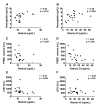Hypothesis: Low Vitamin A and D Levels Worsen Clinical Outcomes When Children with Sickle Cell Disease Encounter Parvovirus B19
- PMID: 36014920
- PMCID: PMC9414848
- DOI: 10.3390/nu14163415
Hypothesis: Low Vitamin A and D Levels Worsen Clinical Outcomes When Children with Sickle Cell Disease Encounter Parvovirus B19
Abstract
Human parvovirus B19 causes life-threatening anemia due to transient red cell aplasia (TRCA) in individuals with sickle cell disease (SCD). Children with SCD experiencing profound anemia during TRCA often require red blood cell transfusions and hospitalization. The prevalence of vitamin deficiencies in SCD is high and deficiencies are associated with respiratory and pain symptoms, but the effects of vitamins on acute infection with parvovirus B19 remain unclear. We performed a clinical study in which 20 SCD patients hospitalized with parvovirus B19 infections (Day 0) were monitored over a 120-day time course to query relationships between vitamins A and D and clinical outcomes. There were significant negative correlations between Day 0 vitamin levels and disease consequences (e.g., red blood cell transfusion requirements, inflammatory cytokines). There were significant positive correlations (i) between Day 0 vitamins and peak virus-specific antibodies in nasal wash, and (ii) between Day 0 virus-specific serum plus nasal wash antibodies and absolute reticulocyte counts. There was a significant negative correlation between Day 0 virus-specific serum antibodies and virus loads. To explain the results, we propose circular and complex mechanisms. Low baseline vitamin levels may weaken virus-specific immune responses to permit virus amplification and reticulocyte loss; consequent damage may further reduce vitamin levels and virus-specific immunity. While the complex benefits of vitamins are not fully understood, we propose that maintenance of replete vitamin A and D levels in children with SCD will serve as prophylaxis against parvovirus B19-induced TRCA complications.
Keywords: parvovirus B19; sickle cell anemia; vitamins A and D.
Conflict of interest statement
J.S.H. receives consulting fees from Global Blood Therapeutics, Forma Therapeutics, and CVS Health. The funders had no role in the design of the study; in the collection, analyses, or interpretation of data; in the writing of the manuscript, or in the decision to publish the results.
Figures




References
MeSH terms
Substances
Grants and funding
LinkOut - more resources
Full Text Sources
Medical

